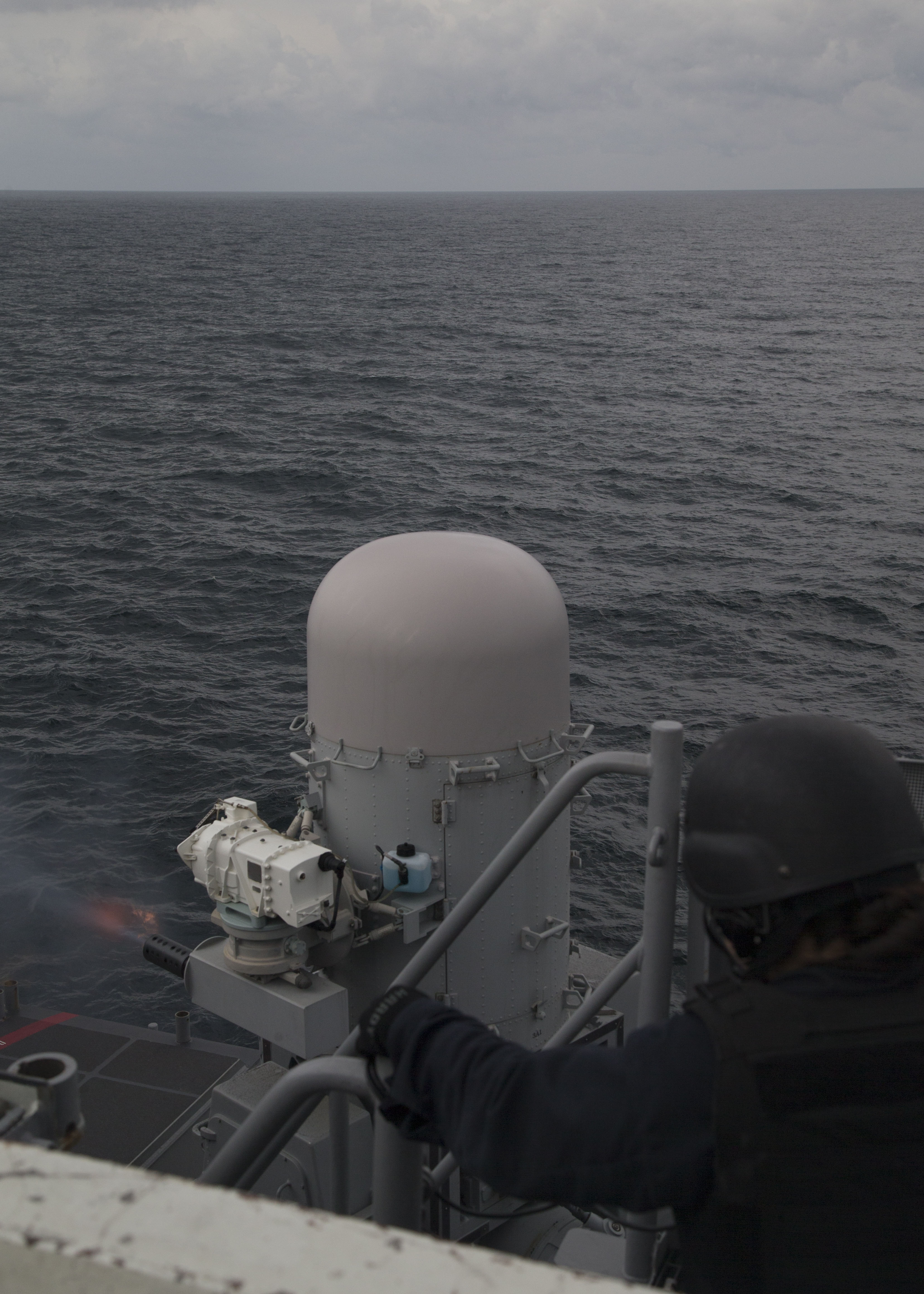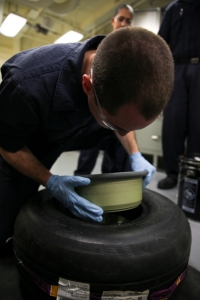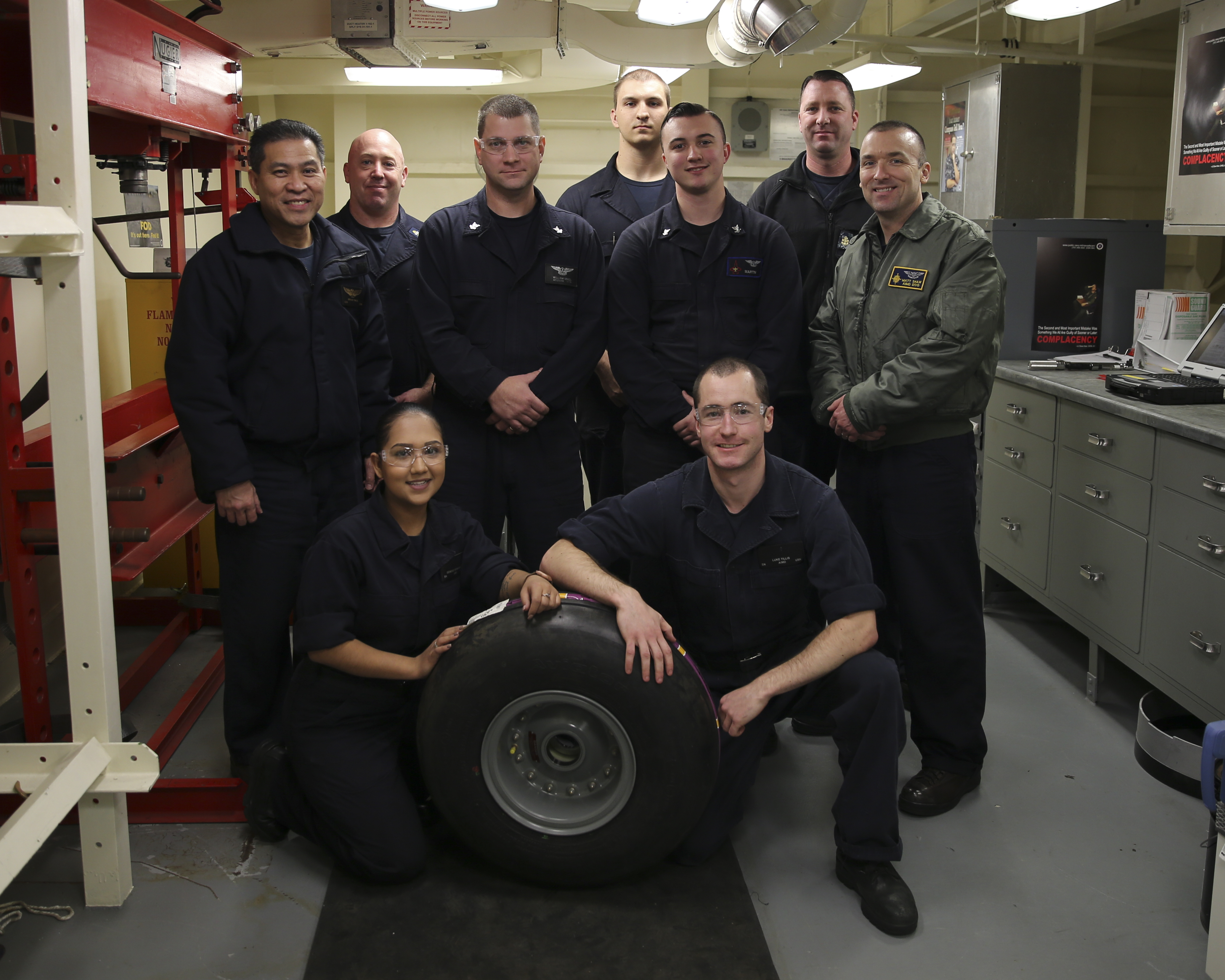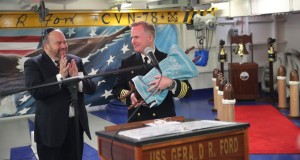A Birthday Gift to the Nation – Warship 78
By Mass Communication Specialist 2nd Class Kallysta Castillo
USS Gerald R. Ford Public Affairs
ATLANTIC OCEAN — On July 14, the birthday of the 38th President of the United States, the Honorable Gerald R. Ford Jr, the crew of USS Gerald R. Ford (CVN 78) celebrates the legacy of their ship’s namesake and reflects on the impact his values have had on their accomplishments over the past year.
As reflected in the ship’s motto “Integrity at the Helm,” Ford’s crew takes great pride in the former president’s renowned key values of integrity, honesty and hard-work. President Ford displayed these values throughout the course of his life, and most notably, during his term as president.
Gerald R. Ford was the only president to achieve the rank of Eagle Scout, an honor to which he attributed his core leadership principles of self-discipline, teamwork and moral patriotism. These values became useful to him when he assumed office on August. 9, 1974 – during a time of diplomatic turmoil – when he would apply these principles to restore trust in the American political system.
Aviation Boatswain’s Mate (Equipment) Airman Casee Ford, from Fort Collins, Colorado, assigned to Ford’s air department, said that sharing the Ford name with the former president makes her proud to serve aboard the ship and that she strives to personally embody his values.
“Serving on this ship makes me want to hold up President Ford’s principles of honesty, integrity and hard work,” said Ford. “I am happy this is my first command. I love that I can be a part of history by being on this ship and sharing the same last name with our namesake.”
Capt. Paul Lanzilotta, Ford’s commanding officer, believes that President Ford’s legacy is not just something crew members should learn about during command indoctrination, but that every Sailor on CVN 78 should understand that his legacy is a direct reflection of his character. To that end, Lanzilotta crafted the command’s mission, vision and guiding principles, embodied in the phrase “Undeniable Excellence and Absolute Ownership,” on the same attributes that made President Ford successful.
“President Ford’s character is alive and well in the crew of this fine warship,” said Lanzilotta. “Our mission, vision and guiding principles are in every way a reflection of the legacy he leaves behind. Any effective organization is built on trust, and the central element of trust is personal integrity. I trust that my Sailors will do the right thing, even when it’s difficult, and they prove that to me on a daily basis.”
The ship reached several significant milestones over the past year of post-delivery test and trials, including qualifying nearly 400 student naval aviators and fleet replacement squadron pilots, marking 8,157 arrested landings and catapult launches, successfully firing missiles and rounds from each of the ship’s weapons systems during combat systems ship’s qualification trials (CSSQT) and completing the first scheduled explosive event of Full Ship Shock Trials (FSST).
Lanzilotta said he believes that President Ford’s values are interlaced within the fabric of the ship’s achievements and are an example of guiding principles at work.
“It took a lot of strength and tenacity for this crew to realize these accomplishments,” Lanzilotta reflected. “Each person, working together as a team, added to our collective skillsets and knowledge, and that is how we have come to reach this level of undeniable excellence. From CSSQT, to integrated CSG (Carrier Strike Group) operations, to full ship shock trials – each of these evolutions is a direct result of our namesake’s integrity and how we apply it to the way we do business.”
Airman Ford said that she sees the former president’s virtues consistently exemplified throughout the ship in her fellow Sailors’ work ethic and commitment to excellence.
“Our ship embodies President Ford’s qualities by continuously working hard when we are out to sea and preparing for our upcoming maintenance period,” said Ford. “We are helping the future of the Fleet’s Sailors to learn our new systems and perfect their functionality.”
As the ship prepares to enter a scheduled maintenance availability, Lanzilotta said he anticipates the same values President Ford embodied to continue to be upheld by the crew throughout this year, during the yard period and beyond.
“It took teamwork and integrity to bring us this far, and it is those same attributes that will show the world what this first-in-class warship is truly capable of,” said Lanzilotta. “We have a broad scope of accomplishments ahead, and we will continue forward with the morals and values of our namesake and lead the future of naval aviation to new heights as we demonstrate our expanded capabilities as a flagship.”
Ford is underway in the Atlantic Ocean conducting FSST. The U.S. Navy conducts shock trials of new ship designs using live explosives to confirm that our warships can continue to meet demanding mission requirements under the harsh conditions they might encounter in battle.

 (ATLANTIC OCEAN) – While underway for Independent Steaming Exercise Five, USS Gerald R. Ford (CVN 78) completed 401 catapults and arrestments, bringing the total to date to 747. On the final day, Jan. 19, the Ford and Carrier Air Wing 8 team completed 135 traps.
(ATLANTIC OCEAN) – While underway for Independent Steaming Exercise Five, USS Gerald R. Ford (CVN 78) completed 401 catapults and arrestments, bringing the total to date to 747. On the final day, Jan. 19, the Ford and Carrier Air Wing 8 team completed 135 traps.  Mass Communication Specialist 2nd Class Kiana A. Raines
Mass Communication Specialist 2nd Class Kiana A. Raines U.S. Navy story by Mass Communication Specialist 3rd Class Ryan Carter
U.S. Navy story by Mass Communication Specialist 3rd Class Ryan Carter
 U.S. Navy story by USS Gerald R. Ford (CVN 78) Public Affairs
U.S. Navy story by USS Gerald R. Ford (CVN 78) Public Affairs ATLANTIC OCEAN (Dec. 7, 2017) – An aircraft carrier’s mission symbolizes what the modern Navy is all about: the projection of power from the sea. In order to accomplish this, aircraft carriers are needed to launch and recover aircraft, and a certain department aboard these carriers is vital in the support of this mission. USS Gerald R. Ford’s (CVN 78) Aircraft Intermediate Maintenance Department (AIMD) Sailors are doing their part to continue the sequence of milestones for the ship.
ATLANTIC OCEAN (Dec. 7, 2017) – An aircraft carrier’s mission symbolizes what the modern Navy is all about: the projection of power from the sea. In order to accomplish this, aircraft carriers are needed to launch and recover aircraft, and a certain department aboard these carriers is vital in the support of this mission. USS Gerald R. Ford’s (CVN 78) Aircraft Intermediate Maintenance Department (AIMD) Sailors are doing their part to continue the sequence of milestones for the ship.






